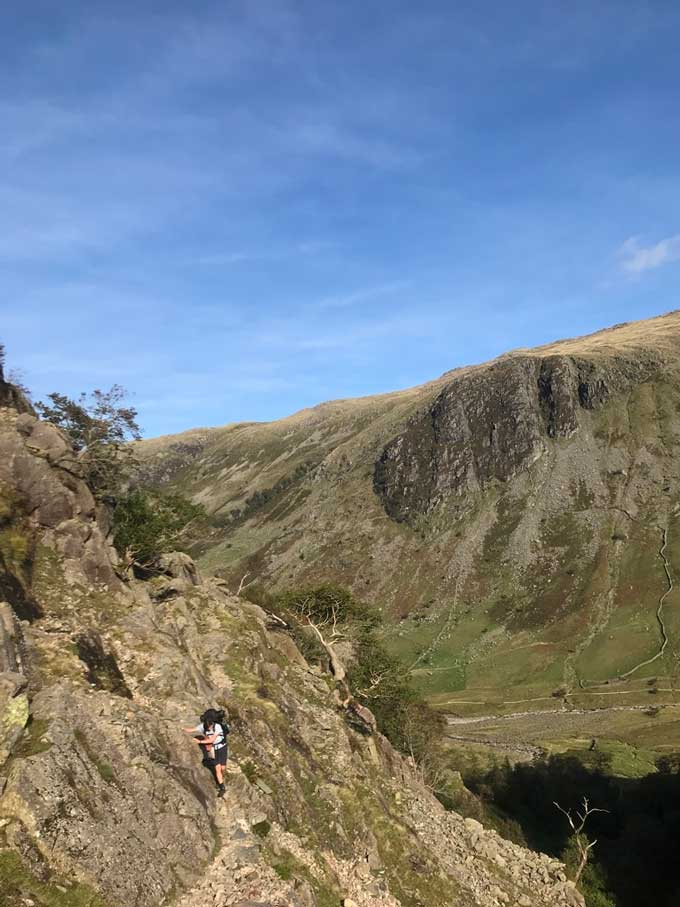A good pair of briefs can make or break your outdoor adventure. Get it wrong and you're in for a world of pain and discomfort. We've put our research hats on to make sure everything is as comfy as can be down there.
Super soft and comfortable merino wool means next to the skin comfort. Lightweight with great moisture wicking properties, the Smartwool Merino Boxer Briefs are a great base layer for warm conditions. They're tough - merino fibres are wrapped around a nylon core for added durability without sacrificing comfort. Smooth seams and wide, elasticated merino covered waistband let you move freely without chafing.
Merino wool comes into its own for keeping smells at bay thanks to its anti microbial properties, meaning you can wear these bad boys day after day with confidence. They're a nice fit – not too loose but not too constricting and the leg length is just right to avoid irritating roll ups.
Material - 87% merino wool, 13% nylon
Cut - boxer brief - also available in brief cut
Colours available - black, pacific stripe, black marble wash, military olive, light grey heather, deep navy stripe, black stripe, light grey heather stripe, deep navy
These breathable boxers are great for any outdoor activity. The antimicrobial properties in the fabric helps keeps unwanted pongs at bay; they're not as effective as merino wool underwear but that's to be expected. The Give-n-Go have a breathable mesh which allows air to circulate, meaning they'll keep you dry through the most strenuous of activities. The thin fabric means they're quick drying - Just throw them in the machine or the sink, and they're dry in no time.
They're lightweight which makes them a great choice for backpackers or those looking to shave some weight. The active fit gives you all the support you need, and although synthetics aren't usually as comfortable as merino, these come pretty close.
Material - 92% Nylon, 8% Lycra Spandex
Cut - boxer brief
Colours available - phantom, black
Outdoor Research have produced a whole range of outdoor gear made from their Echo fabric; it's designed to be both light and breathable and the Echo brief does not disappoint.
Weighing in at an incredible 2.2 ounces, they're amongst the lightest underwear we've seen – you can easily throw in an extra pair or two when you're packing. They'll appeal to fastpackers and weight conscious backpackers although the material feels very thin, so we do wonder how durable it'll be.
The synthetic material feels soft against the skin, and the seams are flat lock to reduce risks of chafing. The thinness of the material means that they're quick drying even in the sweatiest conditions.
Material - 100% AirVent polyester
Cut - boxer brief
Colours available - blue/purple, blue/red
Made from the same wicking material as SAXX's Vibe, the Ultra is designed for a more relaxed fit for greater freedom of movement. It's looser around the leg and has Saxx's unique three-D fit – fabric panels are shaped around the glutes, quads, thighs and hamstrings. Their philosophy is fit, feel and function and the Ultra ticks all three boxes. There's a choice of pretty cool designs too.
SAXX briefs are equipped with their patented and rather wittingly named BallPark pouch – a 3D hammock-shaped support keeps everything in place with sport mesh panels preventing friction from skin rubbing against skin. All this and they still manage to include a functional fly.
Material - 95% viscose, 5% elastane
Cut - boxer brief – also available in brief cut
Colours available - as well as the usual black, navy and grey there’s a whole load of funky colour combos
Featuring Under Armour's innovative HeatGear fabric, these super-breathable shorts are designed to suck the sweat away so you can dry out fast. The fabric is also 4-way stretchable to allow for full freedom of movement. These are compression-style shorts which fit close enough to move with you and feel like a second skin.
Net inserts in the gusset and the inseam panels allow for extra ventilation to keep things cool down there. A broad waist band helps them sit comfortably and stops the material from riding up.
UPF 30+ helps protect skin from harmful UV rays. They have a better odour control than other synthetic underwear for hiking, so your mates will appreciate them too.
Material - 98% polyester, 21% elastane. Netting: 92% polyester, 8% elastane
Cut - compression shorts
Colours available - black, carbon heather, white, royal, academy blue, graphite, Mediterranean, red
New Zealand based Icebreaker are one of the best-known manufacturers of merino wool-based gear, and these briefs are a worthy addition to their brand. Like the Smartwool Merino, the Icebreaker uses ultralight and breathable 150 corespun merino wool for extra strength without sacrificing softness.
The blend of merino wool and nylon makes them comfy, yet durable, and the touch of Lycra gives a generous freedom of movement. Icebreaker use wool that's ethically sourced from local merino sheep so you know you're buying ethically.
A contoured pouch supports the boys nicely and flat lock seams help prevent rubbing and chafing. Of course, you also get merino's natural antimicrobial properties and great moisture wicking abilities.
Material - 83% merino wool, 12% nylon, 5% Lycra
Cut - boxer brief – also available in brief cut
Colours available - black jet heather, midnight navy, metro heather, coyote, serene blue
These merino boxers by Decathlon are a great option for hikers on tough extended trips. Tried and tested in the mountains, the Forclaz Trek are super light, weighing in at around 80g so you don't need to worry about adding extra weight to your pack. At this price and weight you could pop in a couple of spares, although the merino content means you won't need to wash them too often so you could save the weight for beer instead!
Ultrafine 18.5 micron merino wool is soft and comfy plus you benefit from merino's natural breathability and moisture wicking ability to keep you dry. Decathlon only use ethically sourced and cruelty free wool, making them a great budget option for fans of merino wool.
Material - 86% merino wool, 10% polyamide, 4% elastane
Cut - boxer brief
Colours available - black, whale grey
The merino wool used in these boxers is graded ultrafine which means they'll feel good against the skin, even when slightly damp. Although the wool's fairly thin at 170gm, they're still thicker than other merino briefs, which makes them more hard wearing but they do lose some of the softness. Designed to be worn as a base layer, they're a good choice for summer hikes as well as winter adventures as they'll help regulate temperature in hot or cold weather.
The Minus 33s are equipped with a fly and the flatlock seams means they're less likely to rub. They're made using Total Easy Care technology; the wool is treated so that the colour and shape is kept after washing and drying. Unlike some merino briefs they can even be tumble dried on a low setting.
Material - 100% merino wool
Cut - boxer brief
Colours available - black, navy, azure blue, desert sand, zephyr green, mossy oak
Made for movement, the Motus SL boxer is designed for pushing it hard on long hikes and tough trail runs. Superlight Silkweight Phasic FL fabric technology will wick moisture away which speeds up drying time. It's also stretchy and gives next to the skin comfort.
Arc'tery have created the Motus SL with backpackers and trail runners in mind - they'll give a great performance in a variety of conditions and temperatures. The Phasic FL fabric has also been treated to give a degree of odour control for back-to-back days on the trail.
You're buying ethically too - they're produced in a Fair Trade facility as part of Arc'teryx's commitment to transition 80% of their products to Fair Trade certification by 2025.
Material - 100% Phasic FL polyester
Cut - boxer
Colours available - glade, black, binary, limitless
Shreddies, skivvies, undercrackers… whatever you want to call them, your underwear is probably the last thing you think about when planning a hike. Yet, all great adventures start with the basics, and the one piece of gear you don't want to overlook is the first thing you put on.
Wear the wrong underwear for hiking and your trip will be memorable for the wrong reasons. Instead of the fun you had, the trail banter or the great views, all you'll remember is how much pain you were in from being rubbed raw. Yikes.
The best hiking underwear is the stuff you can put on and forget you're wearing. It'll be soft, breathable, quick drying, stay in one place and won't leave you feeling sore in places you'd rather not mention.
We've put on our research hats and come up with some of the best men's hiking underwear options out there to keep your nether regions happy, dry and pain free.
Ladies - we've got you covered too!

Best for: everyday use – Smartwool Merino 150 Boxer Briefs
Best for: multi day hiking and bikepacking – ExOfficio Give-n-Go Sport Boxer Briefs
Best for: Fastpackers and weight conscious back packers – Outdoor Research Echo Boxer Brief
Best for: multi activities – SAXX Underwear Mens Ultra Boxer Brief
Best for: hot conditions – Under Armour HeatGear Compression Shorts
Best for: odour control – Icebreaker Anatomica Boxer Briefs
Best for: best budget buy – Forclaz Trek 500 Merino
Best for: mountain hikes - Minus 33 Acadian Boxer Briefs
Best for: trail runners and faster hikers – Arc’teryx Motus SL Boxers

Underwear for hiking is generally made from either merino wool or synthetic materials. So what’s the difference?
Think wool and you'd be forgiven for imagining old-fashioned bulky underwear. Merino wool is in a league of its own; it's lightweight yet super soft and comfortable against the skin. It's also breathable – it has great moisture wicking abilities and will suck sweat away from the skin, yet it still feels good even when it's damp.
Merino wool is naturally antimicrobial, meaning you can wear your underwear day after day without washing. There are a couple of downsides of merino wool; it's usually more expensive and as it's not as hard-wearing as synthetic fabrics you'll need to replace it more often.
Clothing made from synthetic fabrics is usually cheaper and lasts longer. Synthetic hiking underwear generally has good moisture wicking properties, is breathable and quick drying. Synthetic fabrics are often treated to make them odour resistant, but this can wear off over time as they're washed.
The downside of synthetics is that they don't feel as soft and comfortable against the skin as merino wool, particularly when they're wet.
Often manufacturers combine merino with synthetic fabric to get the best of both worlds – super softness and durability. Some products use corespun merino, where the wool is wrapped round a nylon core, while others pair merino up with synthetic fabric for stretch and freedom of movement.
Men's hiking underwear generally comes in either brief, boxer or compression boxer briefs. Briefs keep everything supported and in its place, but there's not much protection if you suffer from chafing. Whatever you go for, try and look for flat lock seams, as these will prevent chafing and make the underwear feel light on the skin.
Boxers tend to be looser cut and resemble shorts in style. They offer good ventilation and the best freedom of movement, plus they help prevent inner-thigh chafing. However the looser material can bunch up.
Boxer briefs are fast becoming the most popular cut as they give you the best of both worlds – more coverage and a snugger fit. They’re designed to keep everything in place when you move.
Compression boxer briefs are designed to hug your body close whilst applying gentle pressure. This can help prevent the usual muscle fatigue and soreness that comes after a tough workout or day spent on the hills. They're also designed to increase the flow of oxygen to different parts of your body, giving greater muscle function and performance. This can help tired muscles recover as they increase blood flow to the muscle tissue, encouraging it to heal. If you suffer from chafing, compression briefs might be worth a try as they fit tightly against the body so friction isn't such an issue.
They do have their disadvantages though; underwear that's too constricting can start to chafe if worn for days without being washed, though boxers that are too loose can ride up and cause chafing too.
Whatever the cut, most hiking underwear has flat lock seams to help reduce rubbing and they're designed to allow for repetitive movement.
The best hiking underwear for you very much depends on what you're used to and are comfortable with. There's no right or wrong when it comes to the cut – just wear what feels right for you

Fancy a cheeky wild camp? Check out our ultimate guide to wild camping!
Well, you can, but just because you can doesn’t mean you should. Everyday briefs are usually made from cotton, which just isn’t breathable or moisture wicking. You’ll end up wet, uncomfortable and possibly red raw from chafing – most unpleasant.
Underwear for hiking is cut specifically to allow for the repeated movement of walking or running, plus it’s made from fabrics that are moisture wicking and quick drying. As for odour control, well, after a few days on the trail your normal skivvies will probably march to the washing machine on their own!
If they’re synthetics, they should be fine on a regular washing machine cycle, but anything containing merino needs a cooler cycle.
Don’t use laundry detergent as this destroys the wicking properties of outdoor gear - use liquid soap instead.
It’s not a good idea to put your hiking underwear in the drier, unless you want them ultra tight! Pull them into shape and let them dry naturally – they're quick drying so this won’t take long. Checking the washing instructions on the label before their first wash.
Great question! There aren’t too many laundry facilities out there on the hills. You may get lucky at some of the larger campsites but otherwise it’s down to you to keep your underwear fresh.
If your skivvies are made from merino wool, you can get away with wearing them several days at a time without washing them, but you’ll want to clean synthetics more often than that, especially if you’re sharing a tent.
Just swish them around in soapy water (you can buy soap that washes everything), give them a rinse, squeeze as much of the liquid out as you can and hang them to dry. If it’s wet, hang them in your tent, and if it’s sunny your undies can be hung on the outside of your backpack. Just make sure you attach them securely so you don’t lose them.
If it’s a decent day you can expect them to dry overnight or within a few hours.
See above - if your briefs aren't wicking away the sweat, you'll end up pretty uncomfy at the end of a long hot day, not to mention smelly. You might find yourself sitting on your own for that post-walk pint!
The best men's hiking underwear for you depends on personal preference and what you'll be doing with it. Going on a multi-day hike? You'll want underwear that's lightweight, odour repelling and prevents chafing, such as the Icebreaker Anatomica or the Arc'teryx Modus SL Ultra.
The Under Armour HeatGear will keep you cool and dry out there. Into other sports as well as hiking? The SAXX Ultra is a great all-rounder. Looking to shave a few ounces on weight? Check out the Outdoor Research Echo as they're the lightest men's underwear we've found.
Think about what you're comfy with and go with that. You'll also need to consider whether you want underwear with a fly or whether you can do without. No fly means fewer seams, which prevents chafing but it isn't as convenient when nature calls.
Super soft and comfortable merino wool means next to the skin comfort. Lightweight with great moisture wicking properties, the Smartwool Merino Boxer Briefs are a great base layer for warm conditions. They're tough - merino fibres are wrapped around a nylon core for added durability without sacrificing comfort. Smooth seams and wide, elasticated merino covered waistband let you move freely without chafing.
Merino wool comes into its own for keeping smells at bay thanks to its anti microbial properties, meaning you can wear these bad boys day after day with confidence. They're a nice fit – not too loose but not too constricting and the leg length is just right to avoid irritating roll ups.